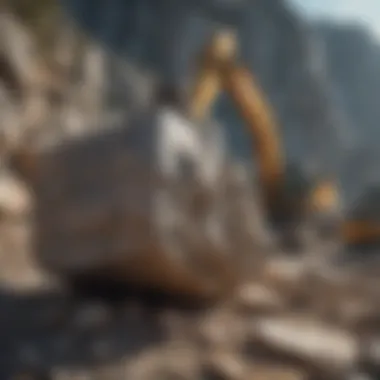Unveiling the Enigmatic Nature of Granite: A Geological and Aesthetic Journey


Rock and Fossil Identification
Granite, a remarkable rock that holds a myriad of mysteries, is a prime subject for both collectors and enthusiasts in the field of geology. As an igneous rock formed from the cooling and solidification of magma, granite displays an array of unique characteristics that set it apart from other rocks. When identifying granite, one should pay attention to its speckled appearance, comprising various minerals such as quartz, feldspar, and mica, which contribute to its distinct color patterns and textures. Utilizing tools like a geologist's hammer and a magnifying glass can aid collectors in discerning the intricate details and compositions embedded within granite specimens.
Geological Insights
Delving further into the geological origins of granite unveils fascinating insights into its formation and composition. Through the study of geological formations and processes, such as the Earth's tectonic movements and the interplay of heat and pressure beneath the surface, granite emerges as a resilient and enduring rock with a rich history spanning millions of years. Its presence in various historical landmarks and discoveries signifies the intrinsic ties between granite and the Earth's geological evolution, making it a subject of continual fascination for researchers and collectors alike.
Introduction
Granite, a multifaceted and enduring rock, stands as a testament to the intricate workings of our planet's geology. This introductory section sets the stage for a captivating exploration into the mysteries encapsulated within granite's rugged exterior. The significance of understanding granite lies not only in its structural composition but also in its profound geological narrative and its myriad applications in architecture and design. By unraveling the complexities of granite, we embark on a journey delving deep into the heart of one of Earth's most enigmatic formations.
Understanding Granite
Composition of Granite
Granite's composition serves as a cornerstone in comprehending its essence and versatility. Comprised primarily of quartz, feldspar, and mica, granite embodies a durable and visually striking amalgamation of minerals. The interlocking crystals within granite grant it exceptional strength and a radiant appearance that varies in hues from whites to pinks to blacks. This diverse palette, coupled with its innate durability, renders granite an optimal choice for a myriad of applications, from kitchen countertops to monumental sculptures. While its hardness and resistance to weathering make granite a prized material, its heaviness and susceptibility to chipping in certain instances present minor drawbacks in specific contexts.
Formation Process
The formation process of granite is a fascinating journey through immense heat and pressure. Born deep within the Earth's crust through the slow cooling and solidification of molten rock, granite undergoes a transformation unlike any other rock type. This intricate process imbues granite with its characteristic crystalline structure and unique mineral content. As granite intrusions push through existing rock formations over geological timescales, they create mesmerizing patterns and veins that distinguish granite from other stones. While this prolonged formation process leads to granite's exceptional hardness and durability, it also means that quarrying and shaping granite require specialized equipment and techniques to harness its full potential.
Geological Insights
In the realm of granite exploration, understanding the geological insights plays a pivotal role in unraveling the mysteries concealed within this exceptional rock. The significance of delving into the geological aspects of granite lies in uncovering its origins, development, and the intricate processes that have shaped its composition over millennia. By shedding light on the geological insights, we gain a deeper appreciation for the resilience and timeless appeal of granite as a geological treasure trove.
Origin and Development
Granite Intrusions
The phenomenon of granite intrusions stands as a significant aspect in the narrative of granite's formation. These intrusions refer to the process where molten rock seeps into existing rock formations, creating veins of granite within them. The key characteristic that makes granite intrusions particularly fascinating is their ability to transform the surrounding rock, influencing its properties and aesthetic appeal. This interplay of different rock materials not only enhances the geological diversity but also contributes to the unique geological signatures found in granite landscapes.
Granite intrusions are a popular choice for study in this article due to their distinctive role in shaping the geological structure and composition of granite deposits. Their intrusive nature sets them apart as agents of change, infusing granite formations with their distinct qualities. While the advantages of granite intrusions lie in their ability to create visually striking patterns and mineral compositions, potential disadvantages may arise from the alteration of the nearby rocks' original characteristics.
Geological Time Scale


The exploration of granite within the context of the geological time scale offers valuable insights into the rock's development and evolution across epochs. By aligning granite's formation with the long expanse of geological time, we gain a comprehensive understanding of its enduring nature and the changes it has undergone through millennia. The geological time scale serves as a beneficial tool for placing granite within the broader scope of Earth's history, highlighting its resilience and timeless presence.
The key characteristic of integrating the geological time scale into this article lies in providing readers with a chronological framework to grasp the vast timescales involved in granite formation. By contextualizing granite's existence within epochs, we establish a profound connection between the rock and the geological forces that have shaped it. While the unique feature of the geological time scale lies in its ability to offer a historical narrative of granite's journey, potential disadvantages may include the complexity of correlating specific granite formations with precise geological eras.
Characteristics of Granite
In this article, the focus on the Characteristics of Granite is paramount to understanding the nuances of this versatile rock. Granite's distinct physical properties set it apart as a sought-after material in various industries, from construction to interior design. By examining its unique characteristics, we can appreciate the value and relevance of granite in modern applications.
Physical Properties
Color Variations
Color variations in granite play a crucial role in its appeal and versatility. The diverse range of hues and patterns available in granite not only enhances its aesthetic value but also allows for customizations to suit specific design preferences. The interplay of colors within the rock contributes to its overall visual impact, making it a popular choice for both residential and commercial projects. Understanding the specific color variations of granite enables architects and designers to create distinct and impactful spaces tailored to their clients' needs.
Crystalline Structure
The crystalline structure of granite is a defining feature that influences its strength and durability. Consisting of interlocking mineral crystals such as quartz, feldspar, and mica, the crystalline arrangement gives granite its distinctive texture and resilience. This robust structure makes granite highly resistant to wear and tear, making it an ideal material for high-traffic areas like kitchen countertops and flooring. The unique interlocking crystals also contribute to granite's natural shimmer and depth, adding a luxurious aesthetic to any space.
Durability and Hardness
Mohs Scale Rating
The Mohs Scale rating of granite showcases its exceptional hardness and durability. With a high ranking on the Mohs Scale of Mineral Hardness, granite surpasses many other natural stones in terms of resistance to scratches and abrasions. This outstanding hardness ensures that granite surfaces maintain their pristine appearance even under heavy use, making it a reliable choice for long-term investments in architectural and design projects. Moreover, the superior Mohs Scale rating underscores granite's longevity and value, making it a favored material for both aesthetic and functional purposes.
Weathering Resistance
Granite's weathering resistance is a key attribute that contributes to its longevity and low maintenance requirements. Due to its innate resistance to weathering agents such as moisture, heat, and erosion, granite remains intact and visually appealing even in outdoor settings. This resilience to environmental factors ensures that granite structures retain their beauty and structural integrity over time, requiring minimal upkeep and preserving their original charm. The exceptional weathering resistance of granite makes it a sustainable choice for outdoor applications, embodying both beauty and durability in perfect harmony.
Applications of Granite
In this comprehensive exploration of the mysteries surrounding granite, the section on Applications of Granite holds paramount importance. Highlighting the practical uses and significance of granite in various industries, including architecture and design, this segment delves into the unique characteristics that make granite a preferred material for many applications. With a focus on the versatility and durability of granite, this section aims to shed light on how this resilient rock plays a crucial role in shaping our built environment.
Architectural Marvels
Monuments and Statues


Delving into the realm of architectural marvels crafted from granite, the subsection on Monuments and Statues unveils the intricate beauty and historical significance of these structures. From ancient monuments to contemporary statues, granite stands the test of time with its enduring allure and unique aesthetic appeal. The key characteristic of Monuments and Statues lies in the longevity and weather resistance offered by granite, making it a popular choice for honoring historical figures and commemorating significant events. Despite its durability, the heavy weight of granite statues can pose challenges in transportation and installation, requiring meticulous planning and effort in handling such monumental pieces.
Landmarks and Buildings
Examining the role of granite in defining landmarks and constructing buildings, this subsection sheds light on the architectural prowess and visual impact of granite structures. With its versatility in design and strength, granite is a favored material for creating iconic landmarks and structurally sound buildings worldwide. The key characteristic that sets Landmarks and Buildings apart is the luxurious aesthetic appeal and unmatched durability of granite, making it a sought-after choice for architects and builders aiming for both beauty and longevity. While granite's durability is a significant advantage in construction, the high cost and specialized installation requirements pose challenges in utilizing this premium material extensively.
Design and Decor
Kitchen Countertops
Exploring the realm of design and decor, the subsection on Kitchen Countertops uncovers the elegance and functionality of granite surfaces in culinary spaces. Known for its heat resistance and stain resilience, granite countertops offer both practicality and style to modern kitchens. The key characteristic of Kitchen Countertops lies in their natural beauty and distinct patterns, making each countertop a unique centerpiece in home kitchens. Despite its aesthetic appeal, granite countertops require regular maintenance to preserve their luster, which can be a downside for homeowners seeking low-maintenance options.
Flooring and Wall Cladding
Shifting focus to flooring and wall cladding, this subsection delves into the transformative power of granite in interior design. With its timeless elegance and durability, granite flooring and cladding add sophistication and luxury to living spaces. The key characteristic of Flooring and Wall Cladding lies in the tactile and visual appeal of natural stone, providing a striking backdrop for any interior setting. While granite's resilience and longevity are unparalleled, the high cost and installation complexity may deter some homeowners from incorporating this luxurious material into their design schemes.
Extraction and Processing
Granite extraction and processing play a crucial role in understanding the full scope of this article. The meticulous process of extracting granite from quarries and refining it through cutting and polishing techniques is essential to unleash its full potential. By delving into the Extraction and Processing section, readers will gain insights into the labor-intensive yet rewarding journey from raw granite blocks to exquisite finished products that adorn our surroundings.
Mining Techniques
Quarrying Methods
Quarrying Methods in granite extraction involve intricate processes that revolve around extracting massive granite blocks from quarries with precision and care. High-Quality Quarrying Methods ensure minimal damage to the stone, preserving its natural beauty and integrity. These methods typically involve the use of diamond wire saws or explosives, depending on the hardness of the granite bedrock. The selection of Quarrying Methods is a critical decision that impacts the quality of the extracted stone, making it a pivotal aspect of the extraction process. While Quarrying Methods offer efficiency in obtaining large quantities of granite, they can pose environmental challenges, such as landscape alteration and noise pollution. Balancing efficiency with sustainability is key when implementing Quarrying Methods for granite extraction.
Cutting and Polishing
Cutting and Polishing are transformative stages in granite processing that bring out the inherent beauty and durability of the stone. Precision cutting technologies ensure that granite slabs are shaped according to specific design requirements without compromising structural integrity. Polishing techniques, involving abrasive materials and sealants, give granite its characteristic sheen and smooth finish, enhancing both aesthetics and longevity. The Cutting and Polishing phase is a crucial step in the value chain of granite utilization, as it determines the final appearance and quality of the end products. Despite its advantages in enhancing the visual appeal and durability of granite, Cutting and Polishing processes generate significant waste material and require substantial energy consumption. Efficient waste management and energy-saving strategies are essential in mitigating the environmental impact of Cutting and Polishing practices in granite processing.
Environmental Considerations
In the realm of granite exploration, understanding the critical aspect of Environmental Considerations offers a lens through which we can appreciate the interplay between extracting this majestic stone and preserving our natural surroundings. This segment of the article delves into the pivotal role that sustainable practices play in ensuring the longevity and ecological balance of granite mining and processing.
Sustainability Practices


Reclamation Efforts
Reclamation Efforts stand at the forefront of sustainable granite practices, embodying the commitment to restoring the land to its former state post-extraction. By meticulously planning and executing reclamation strategies, such as re-vegetation and habitat restoration, mining sites can be transformed into renewed ecosystems that benefit local flora and fauna. The key characteristic of Reclamation Efforts lies in their ability to mitigate environmental impact and promote biodiversity, making them instrumental in the holistic approach to granite extraction. While reclamation efforts require investment and time, their long-term advantages in preserving natural habitats and promoting ecological balance underscore their significance in the granite industry.
Waste Management
Waste Management within the granite sector plays a crucial role in minimizing environmental footprint and maximizing resource efficiency. By implementing effective waste management practices, such as recycling stone waste and reducing water usage, the industry can significantly reduce its environmental impact while optimizing operational processes. The unique aspect of Waste Management lies in its multi-faceted approach to waste reduction, encompassing strategies that not only benefit the environment but also improve operational sustainability. Though challenges may arise in the form of initial infrastructure costs and regulatory compliance, the long-term advantages of sustainable waste management practices outweigh the drawbacks, positioning them as essential elements in responsible granite processing.
The integral intersection of Sustainability Practices and Environmental Considerations underscores the industry's commitment to harmonizing natural resource utilization with environmental stewardship. By embracing reclamation efforts and efficient waste management, the granite sector exemplifies a balanced approach that prioritizes preservation while meeting global demand.
Future Prospects
In the realm of granite exploration, examining future prospects becomes a crucial aspect to consider for the continued evolution of its uses and applications. As technology advances and demands shift, the future of granite opens up exciting avenues for innovation and experimentation. Understanding the trajectory of granite use is essential for industries and researchers alike to stay ahead of trends and breakthroughs.
Future prospects in granite involve a dynamic landscape where new materials and applications are constantly being developed. From composite materials to advanced applications, the potential for granite's versatility is vast. By analyzing and predicting future trends in granite utilization, businesses and stakeholders can adapt their strategies to capitalize on emerging opportunities and address challenges.
Innovations in Granite Use
Composite Materials
Exploring composite materials marks a pioneering approach in the realm of granite utilization. These materials combine the robustness of traditional granite with added features such as increased flexibility, lighter weight, or enhanced durability. The integration of composite materials elevates granite's applications to new realms, catering to diverse needs in construction, design, and beyond.
One key characteristic of composite materials is their ability to blend the best qualities of different components, resulting in a product that surpasses the limitations of natural stone. The versatility of composite materials paves the way for innovative design solutions and sustainable practices. With enhanced strength and a more customizable nature, composite materials offer a beneficial choice for those seeking to push the boundaries of traditional granite use.
Innovatively, the unique feature of composite materials lies in their capacity to mimic the aesthetic appeal of natural stone while offering improved functionality. This balance between beauty and performance positions composite materials as a game-changer in the granite industry, attracting interest from architects, designers, and homeowners seeking a fresh take on classic materials.
Advanced Applications
Delving into advanced applications showcases the cutting-edge possibilities that granite presents in modern contexts. Whether it's through advanced fabrication techniques, digital applications, or sustainable initiatives, the world of granite utilization continues to expand and diversify. Advanced applications bring forth a new era of exploration, where traditional uses are reimagined for contemporary challenges and opportunities.
A key characteristic of advanced applications is their emphasis on precision, efficiency, and sustainability. By leveraging technology and innovative processes, granite can be utilized in ways that were previously unthinkable, setting new benchmarks for quality and performance. The integration of advanced applications elevates the usability of granite, making it a preferred choice for projects that demand sophistication and reliability.
The unique feature of advanced applications lies in their ability to push the boundaries of conventional granite utilization, opening up possibilities for groundbreaking designs and structures. By embracing advanced applications, stakeholders in the granite industry can stay at the forefront of innovation and cater to the evolving needs of a dynamic market.
Appreciating Granite
Enduring Beauty
The concept of enduring beauty in granite encapsulates its ability to withstand the test of time without compromising its aesthetic allure. This enduring beauty stems from the diverse color variations present in granite, ranging from deep blacks to shimmering whites, ensuring a mesmerizing visual impact. The crystalline structure of granite further enhances its appeal, reflecting light in unique ways and adding a touch of sophistication to any application. This inherent beauty of granite not only adds value to architectural projects but also allows for a seamless integration of nature's elegance into modern designs. Despite its robust nature, granite manages to exude a sense of grace and charm, making it a popular choice among architects, designers, and homeowners alike.
Timeless Elegance
Timeless elegance in granite embodies the refined sophistication and classic appeal that this rock brings to diverse settings. The intricate veining patterns and unique textures found in granite contribute to its timeless elegance, allowing for a seamless blend of tradition and modernity in architectural and design applications. The durability and weathering resistance of granite ensure that its elegance stands the test of time, transcending fleeting trends and fads. The striking presence of granite, whether in a kitchen countertop or a monumental statue, exudes a sense of grandeur and regality that elevates any space to a realm of timeless beauty and sophistication.







